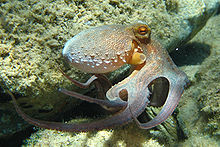| Coleoidea Temporal range: Devonian or Carboniferous –Recent PreꞒ Ꞓ O S D C P T J K Pg N | |
|---|---|

| |
| A cuttlefish | |

| |
| A common octopus | |
| Scientific classification | |
| Domain: | Eukaryota |
| Kingdom: | Animalia |
| Phylum: | Mollusca |
| Class: | Cephalopoda |
| Clade: | Neocephalopoda |
| Subclass: | Coleoidea Bather, 1888 |
| Divisions | |
| |
Coleoidea or Dibranchiata is one of the two subclasses of cephalopods containing all the various taxa popularly thought of as "soft-bodied" or "shell-less" (i.e. octopus, squid and cuttlefish). Unlike its extant sister group Nautiloidea, whose members have a rigid outer shell for protection, the coleoids have at most an internal shell called cuttlebone or gladius that is used for buoyancy or as muscle anchorage. Some species, notably incirrate octopuses, have lost their internal shell altogether, while in some it has been replaced by a chitinous support structure.
The major divisions of Coleoidea are based upon the number of arms or tentacles and their structure. The extinct and most primitive form, the Belemnoidea, presumably had ten equally-sized arms in five pairs numbered dorsal to ventral as I, II, III, IV and V. More modern species either modified or lost a pair of arms. The superorder Decapodiformes has arm pair IV modified into long tentacles with suckers generally only on the club-shaped distal end. Superorder Octopodiformes has modifications to arm pair II; it is significantly reduced and used only as a sensory filament in the Vampyromorphida, while Octopoda species have totally lost that arm pair. The inner surface of the suckers (acetabulum) are reinforced with rigid sucker rings which are smooth in Sepiolida, have blunt teeth in Sepiida and sharply pointed teeth in Loliginidae and Oegopsida. The arms and/or tentacles of some oegopsid families have also evolved claw-like hooks.
Evolutionary history
The earliest certain coleoids are known from the Mississippian sub-period of the Carboniferous Period, about 330 million years ago. Some older fossils have been described from the Devonian, but paleontologists disagree about whether they are coleoids. Other cephalopods with internal shells, which could represent coleoids but may also denote the independent internalization of the shell, are known from the Silurian. It has been hypothesized that the Early–Middle Cambrian fossil Nectocaris represents a coleoid (or other cephalopod) that lost its shell, possibly secondarily, although it is more likely that Nectocaris represents an independent lineage within the Lophotrochozoa.
By the Carboniferous, coleoids already had a diversity of forms, but the major radiation happened during the Tertiary. Although most of these groups are traditionally classified as belemnoids, the variation among them suggests that some are not closely related to belemnites.
Classification
- Class Cephalopoda
- Subclass Nautiloidea: nautilus
- Subclass †Ammonoidea: ammonites
- Subclass Coleoidea
- Division †Belemnoidea: extinct belemnoids
- Genus †Jeletzkya
- Order †Hematitida
- Order †Phragmoteuthida
- Order †Donovaniconida
- Order †Aulacocerida
- Order †Belemnitida
- Division Neocoleoidea
- Superorder Decapodiformes
- Order Bathyteuthida
- Order †Belemnitida
- Order †Diplobelida
- Order Idiosepida
- Order Myopsida – coastal squid
- Order Oegopsida – neritic squid
- Order Sepiida – cuttlefish, pygmy, bobtail and bottletail squid
- Order Spirulida – ram's horn squid
- Superorder Octopodiformes
- Family †Trachyteuthididae (incertae sedis)
- Order Vampyromorphida: vampire squid
- Order Octopoda: octopus
- Superorder Palaeoteuthomorpha
- Order †Boletzkyida
- Superorder Decapodiformes
- (uncertain order)
- family †Ostenoteuthidae
- Division †Belemnoidea: extinct belemnoids
References
- From Greek koleos, sheath
- Nixon, Marion; Young, J. Z. (2003). The Brains and Lives of Cephalopods. New York: Oxford University Press. ISBN 978-0-19-852761-9.
- Fuchs, D.; Hoffmann, R.; Klug, C. (2021). "Evolutionary development of the cephalopod arm armature: A review". Swiss Journal of Palaeontology. 140 (1): 27. Bibcode:2021SwJP..140...27F. doi:10.1186/s13358-021-00241-z. PMC 8688392. PMID 34956072.
- Bandel, Klaus; Reitner, J.; Sturmer, W. (1983). "Coleoids from the Lower Devonian Black Slate ("Hunsruck-Schiefer")". Neues Jahrbuch für Geologie und Paläontologie, Abhandlungen. 165 (3): 397–417. doi:10.1127/njgpa/165/1983/397.
- Zuschin, Martin (2008). "Phylogeny and Evolution of the Mollusca". Marine Ecology. 30 (2): 269. Bibcode:2009MarEc..30..269Z. doi:10.1111/j.1439-0485.2009.00287.x.
- Turek, V.; Manda, Š. (2012). "An endocochleate experiment in the Silurian straight-shelled cephalopod Sphooceras". Bulletin of Geosciences. 87 (4): 767–813. doi:10.3140/bull.geosci.1335.
- Smith, M. R.; Caron, J. B. (2010). "Primitive soft-bodied cephalopods from the Cambrian". Nature. 465 (7297): 469–472. Bibcode:2010Natur.465..469S. doi:10.1038/nature09068. hdl:1807/32368. PMID 20505727. S2CID 4421029.
- Smith, M. R. (2013). "Nectocaridid ecology, diversity and affinity: early origin of a cephalopod-like body plan". Paleobiology. 39 (2): 291–321. Bibcode:2013Pbio...39..297S. doi:10.1666/12029. S2CID 85744624.
- Kröger, Björn; Vinther, Jakob; Fuchs, Dirk (August 2011). "Cephalopod origin and evolution: A congruent picture emerging from fossils, development and molecules: Extant cephalopods are younger than previously realised and were under major selection to become agile, shell-less predators". BioEssays. 33 (8): 602–613. doi:10.1002/bies.201100001. PMID 21681989. S2CID 2767810.
- Boyle, Peter; Rodhouse, Paul (15 April 2008). Cephalopods: Ecology and Fisheries. John Wiley & Sons. ISBN 978-1-4051-4543-5.
- Doguzhaeva, Larisa A.; Mapes, Royal H.; Mutvei, Harry (2007). "A Late Carboniferous Coleoid Cephalopod from the Mazon Creek Lagerstätte (USA) with a radula, arm hooks, mantle tissues, and ink". In Landman, Neil H.; Davis, Richard Arnold; Mapes, Royal H. (eds.). Cephalopods Present & Past: New Insights and Fresh Perspectives. Berkeley & Los Angeles, California, USA: University of California Press. pp. 121–143.
- Garassino, A.; Donovan, D. T. (2000). "A New Family of Coleoids from the Lower Jurassic of Osteno, Northern Italy". Palaeontology. 43 (6): 1019. Bibcode:2000Palgy..43.1019G. doi:10.1111/1475-4983.00160.
External links
- CephBase: Coleoidea
- Tree of Life web project: Coleoidea
- "Octopuses Do Something Really Strange to Their Genes"
| Taxon identifiers | |
|---|---|
| Coleoidea | |